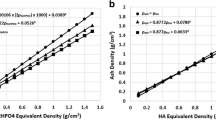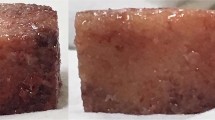Abstract
Summary
This study compares the results of computed tomography X-ray absorptiometry (CTXA) hip volumetric BMD (vBMD) analyses of cortical and trabecular bone with and without partial volume correction. For cortical bone in some circumstances, corrected cortical volumes were negative and corrected vBMD was very high. For trabecular bone, the correction effects are smaller. CTXA volumetric data should be interpreted with caution.
Purpose
Previous studies have reported concerns about the reliability of CTXA hip cortical vBMD measurements generated using partial volume (PV) correction (the “default” analysis, with cortical PV correction). To date, no studies have examined the results of the alternative (“new”) analysis (with trabecular PV correction). This study presents in vivo and phantom data comparing the corrected and uncorrected data for cortical and trabecular bone respectively.
Methods
We used the commercial QCTPro CTXA software to analyze CT scans of 129 elderly Chinese men and women and an anthropomorphic European Proximal Femur phantom (EPFP) and accessed data for two alternative scan analyses using the database dump utility. The CTXA software gives the user two methods of performing the PV correction: (1) a default analysis in which only cortical bone results are corrected; (2) a new analysis in which only trabecular bone results are corrected. Both methods are based on a numerical recalculation of vBMD values without any change in volume of interest (VOI) placement.
Result
In vivo, the results of the two analyses for integral bone were the same while cortical and trabecular results were different. PV correction of cortical bone led to a decrease of cortical volume for all four VOIs: total hip (TH), femoral neck (FN), trochanter (TR), and intertrochanter (IT) volumes were reduced on average by 7.8 cm3, 0.9 cm3, 2.5 cm3, and 4.3 cm3 respectively. For TR, where cortex was thinnest, average corrected cortical volume was negative (− 0.4± 1.3 cm3). Corrected cortical vBMD values were much larger than uncorrected ones for TH, FN, and IT. Scatter plots of corrected cortical vBMD against cortical bone thickness showed that elevated results correlated with thinner cortices. When trabecular bone was corrected for the PV effect, trabecular volumes of TH, FN, TR, and IT were reduced on average by 7.9 cm3, 0.8 cm3, 2.6 cm3, and 4.4 cm3 respectively, while vBMD measurements were increased correspondingly. The trabecular volume and vBMD measurements of the two datasets both had highly positive correlations. For the EPFP, the PV-corrected FN data deviated from the nominal phantom value, but was closer for the TR and IT VOIs. Both corrected and uncorrected data overestimated trabecular vBMD, with the corrected results showing greater deviation from nominal values.
Conclusion
The default and new CTXA analyses for volumetric data generate different results, both for cortical and trabecular bone. For cortical bone, the uncorrected results are subject to partial volume effects but the correction method of the default analysis overcorrects the effect leading to in part unreasonable results for cortical bone volume and BMD. For trabecular bone, the correction effects are smaller. CTXA volumetric data should be interpreted with caution.




Similar content being viewed by others
References
Ferrari S, Reginster JY, Brandi ML, Kanis JA, Devogelaer JP, Kaufman JM, Féron JM, Kurth A, Rizzoli R (2016) Unmet needs and current and future approaches for osteoporotic patients at high risk of hip fracture. Arch Osteoporos 11:37–37. https://doi.org/10.1007/s11657-016-0292-1
Abrahamsen B, van Staa T, Ariely R, Olson M, Cooper C (2009) Excess mortality following hip fracture: a systematic epidemiological review. Osteoporosis Int 20:1633–1650. https://doi.org/10.1007/s00198-009-0920-3
Cosman F, de Beur SJ, LeBoff M, Lewiecki EM, Tanner B, Randall S, Lindsay R, National Osteoporosis Foundation (2014) Clinician’s guide to prevention and treatment of osteoporosis. Osteoporos Int 25:2359–2381. https://doi.org/10.1007/s00198-014-2794-2
Engelke K (2017) Quantitative computed tomography-current status and new developments. J Clin Densitom 20:309–321. https://doi.org/10.1016/j.jocd.2017.06.017
Engelke K, Libanati C, Fuerst T, Zysset P, Genant HK (2013) Advanced CT based in vivo methods for the assessment of bone density, structure, and strength. Curr Osteoporos Rep 11:246–255. https://doi.org/10.1007/s11914-013-0147-2
Wang L et al (2019) QCT of the femur: comparison between QCTPro CTXA and MIAF Femur. Bone 120:262–270. https://doi.org/10.1016/j.bone.2018.10.016
Borggrefe J, Graeff C, Nickelsen TN, Marin F, Gluer CC (2010) Quantitative computed tomographic assessment of the effects of 24 months of teriparatide treatment on 3D femoral neck bone distribution, geometry, and bone strength: results from the EUROFORS study. J Bone Miner Res 25:472–481. https://doi.org/10.1359/jbmr.090820
Ito M, Wakao N, Hida T, Matsui Y, Abe Y, Aoyagi K, Uetani M, Harada A (2010) Analysis of hip geometry by clinical CT for the assessment of hip fracture risk in elderly Japanese women. Bone 46:453–457. https://doi.org/10.1016/j.bone.2009.08.059
Luo Y, Yang H (2018) Comparison of femur stiffness measured from DXA and QCT for assessment of hip fracture risk. J Bone Miner Metab. https://doi.org/10.1007/s00774-018-0926-z
Museyko O, Bousson V, Adams J, Laredo J, Engelke K (2016) QCT of the proximal femur--which parameters should be measured to discriminate hip fracture? Osteoporos Int 27:1137–1147. https://doi.org/10.1007/s00198-015-3324-6
Wang L, Cheng XG, Su YB, Brown K, Xu L, Li K, Zhang CX, Zhang Y, Duanmu YY, Wu XB, Wang MY (2017) Sex-related variations in cortical and trabecular bone of the femoral neck in an elderly Chinese population. Osteoporos Int 28:2391–2399. https://doi.org/10.1007/s00198-017-4043-y
Wang L, Khoo BCC, Cheng XG, Brown K, Lewis JR, Su YB, Guo Z, Li K, Prince RL (2017) Differences in femoral neck structure between elderly Caucasian and Chinese populations: a cross-sectional study of Perth-Beijing cohorts. Arch Osteoporos 12:72–78. https://doi.org/10.1007/s11657-017-0366-8
Amstrup AK, Jakobsen NF, Lomholt S, Sikjaer T, Mosekilde L, Rejnmark L (2016) Inverse correlation at the hip between areal bone mineral density measured by dual-energy X-ray absorptiometry and cortical volumetric bone mineral density measured by quantitative computed tomography. J Clin Densitom 19:226–233. https://doi.org/10.1016/j.jocd.2015.01.002
Cann CE, Adams JE, Brown JK, Brett AD (2014) CTXA hip--an extension of classical DXA measurements using quantitative CT. PLoS One 9:e91904. https://doi.org/10.1371/journal.pone.0091904
Black DM, Bouxsein ML, Marshall LM, Cummings SR, Lang TF, Cauley JA, Ensrud KE, Nielson CM, Orwoll ES, Osteoporotic Fractures in Men (MrOS) Research Group (2008) Proximal femoral structure and the prediction of hip fracture in men: a large prospective study using QCT. J Bone Miner Res 23:1326–1333. https://doi.org/10.1359/jbmr.080316
Cheng X, Li J, Lu Y, Keyak J, Lang T (2007) Proximal femoral density and geometry measurements by quantitative computed tomography: association with hip fracture. Bone 40:169–174. https://doi.org/10.1016/j.bone.2006.06.018
Johannesdottir F, Poole KE, Reeve J, Siggeirsdottir K, Aspelund T, Mogensen B, Jonsson BY, Sigurdsson S, Harris TB, Gudnason VG, Sigurdsson G (2011) Distribution of cortical bone in the femoral neck and hip fracture: a prospective case-control analysis of 143 incident hip fractures; the AGES-REYKJAVIK Study. Bone 48:1268–1276. https://doi.org/10.1016/j.bone.2011.03.776
Poole KE, Mayhew PM, Rose CM, Brown JK, Bearcroft PJ, Loveridge N, Reeve J (2010) Changing structure of the femoral neck across the adult female lifespan. J Bone Miner Res 25:482–491. https://doi.org/10.1359/jbmr.090734
Jorgenson BL, Buie HR, McErlain DD, Sandino C, Boyd SK (2015) A comparison of methods for in vivo assessment of cortical porosity in the human appendicular skeleton. Bone 73:167–175. https://doi.org/10.1016/j.bone.2014.11.023
Cheng X et al (2014) Validation of quantitative computed tomography-derived areal bone mineral density with dual energy X-ray absorptiometry in an elderly Chinese population. Chin Med J 127:1445–1449
Engelke K, Lang T, Khosla S, Qin L, Zysset P, Leslie WD, Shepherd JA, Schousboe JT (2015) Clinical use of quantitative computed tomography (QCT) of the hip in the management of osteoporosis in adults: the 2015 ISCD official positions-part I. J Clin Densitom 18:338–358. https://doi.org/10.1016/j.jocd.2015.06.012
Khoo BC, Brown K, Cann C, Zhu K, Henzell S, Low V, Gustafsson S, Price RI, Prince RL (2009) Comparison of QCT-derived and DXA-derived areal bone mineral density and T scores. Osteoporos Int 20:1539–1545. https://doi.org/10.1007/s00198-008-0820-y
Bjornerem A (2016) The clinical contribution of cortical porosity to fragility fractures. BoneKEy Rep 5:846. https://doi.org/10.1038/bonekey.2016.77
Zebaze R, Libanati C, McClung M, Zanchetta JR, Kendler DL, Høiseth A, Wang A, Ghasem-Zadeh A, Seeman E (2016) Denosumab reduces cortical porosity of the proximal femoral shaft in postmenopausal women with osteoporosis. J Bone Miner Res 31:1827–1834. https://doi.org/10.1002/jbmr.2855
Acknowledgments
The authors would like to thank Prof. Klaus Engelke (Department of Medicine 3, University Hospital, University of Erlangen-Nürnberg FAU) and Prof. Glen M. Blake (School of Biomedical Engineering & Imaging Sciences, King’s College London, St Thomas’ Hospital) for their most helpful comments on drafts of this paper.
Funding
This study was supported by grants from the Beijing Bureau of Health 215 program (grant nos. 2013-3-033, 2009-2-03), the Beijing Natural Science Foundation-Haidian Primitive Innovation Joint Fund (grant no. L172019), the National Natural Science Foundation of China (grant no. 81771831; 81901718), Beijing Jishuitan Hospital Nova Program (grant no. XKXX201812), and Beijing Talents Fund (grant no. 015000021467G177).
Author information
Authors and Affiliations
Corresponding author
Ethics declarations
Conflict of interest
K. Brown is a stockholder of Mindways Inc. Y. Liu, L. Wang, Y. Su, R. Yang, Y. Zhang, Y. Duanmu, Z. Guo, W. Zhang, C. Yan, D. Yan, and X. Cheng declare that they have no conflict of interest.
Additional information
Publisher’s note
Springer Nature remains neutral with regard to jurisdictional claims in published maps and institutional affiliations.
Y. Liu and L. Wang should be considered co-first authors.
Rights and permissions
About this article
Cite this article
Liu, Y., Wang, L., Su, Y. et al. CTXA hip: the effect of partial volume correction on volumetric bone mineral density data for cortical and trabecular bone. Arch Osteoporos 15, 50 (2020). https://doi.org/10.1007/s11657-020-00721-8
Received:
Accepted:
Published:
DOI: https://doi.org/10.1007/s11657-020-00721-8




